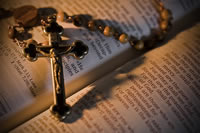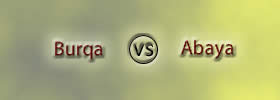Difference between Catholic and Christian Bible
Key difference: The Catholic Bible contains the original forty-six books of the Old Testament, (which includes the seven books of the Apocrypha) and the twenty-seven books of the New Testament. The Protestant Bible only includes the thirty-nine books of the Old Testament and the twenty-seven books of the New Testament.
 The main problem while differentiating between Catholic and Christian arises when many do not realize that the Roman Catholicism is a sect of Christianity, just as the Eastern Orthodox Church, and the various denominations of Protestantism. The denominations of Protestantism include Lutheran, Baptist, Anglican, Calvin, Quakers, Shakers, etc. So, when we are taking about Catholic and Christian bibles, we are actually referring to bibles used by Catholics and Protestants, respectively.
The main problem while differentiating between Catholic and Christian arises when many do not realize that the Roman Catholicism is a sect of Christianity, just as the Eastern Orthodox Church, and the various denominations of Protestantism. The denominations of Protestantism include Lutheran, Baptist, Anglican, Calvin, Quakers, Shakers, etc. So, when we are taking about Catholic and Christian bibles, we are actually referring to bibles used by Catholics and Protestants, respectively.
A major difference between the Catholic and Protestant churches is their belief regarding the Bibles. Catholics view the Bible as having equal authority with the Church and tradition, whereas, Protestants view the Bible as the supreme authority for faith and practice.
One should note that the Bible is not just one book; it is a collection of books from writings to historical events. It is a library of stories of the life of Jesus, his apostles and their lives after Jesus died on the cross. In late 4th century, these various volumes and stories were complied into one volume, which is essentially the modern bible, as we know it. The modern Bible is composed of two parts: the Old Testament and the New Testament.
Both the Catholic and Protestant Bibles include the New Testament in the same format. The difference arises in the Old Testament. The Old Testament as included in the Protestant Bible underwent canonization of the doctrines or books. Canonization is a process of selecting which books should stay and become part of the Bible, and which should be excluded. The Protestant Bible includes only those books that were deemed to be God’s words. Books and stories that were deemed to be written by ‘man’ were excluded. This process of canonization took many centuries.
The Old Testament in the original Bible was based on a Greek translation of Jewish Scripture, called the Septuagint. Around 100 A.D., Jewish rabbis revised their Scripture and established an official canon of Judaism which excluded some portions of the Greek Septuagint.
The books removed were Tobit, Judith, 1 Maccabees, 2 Maccabees, Wisdom (of Solomon), Sirach, and Baruch. Parts of existing books were also removed including Psalm 151 (from Psalms), parts of the Book of Esther, Susanna (from Daniel as chapter 13), and Bel and the Dragon (from Daniel as chapter 14).
 The Bible continued to use the text of the original Septuagint as the Old Testament. However, in the 1500’s, Protestant leaders decided to organize the Old Testament material according to the official canon of Judaism instead of the Septuagint. They distributed the Old Testament into two parts. The Old Testament material which was not in the Jewish canon was moved into a separate section of the Bible called the Apocrypha. So, the Protestant Bibles now included three parts: the twenty-four books of the Hebrew Bible divided into thirty-nine books as the revised Old Testament, twenty-seven books of the New Testament, including the four Canonical gospels, Acts of the Apostles, twenty-one Epistles or letters and the Book of Revelation, and seven books in the Apocrypha. In the 1800’s the Apocrypha was eventually dropped form the Protestant version of the Bible. The books of the Apocrypha are also known as the deuterocanonical books.
The Bible continued to use the text of the original Septuagint as the Old Testament. However, in the 1500’s, Protestant leaders decided to organize the Old Testament material according to the official canon of Judaism instead of the Septuagint. They distributed the Old Testament into two parts. The Old Testament material which was not in the Jewish canon was moved into a separate section of the Bible called the Apocrypha. So, the Protestant Bibles now included three parts: the twenty-four books of the Hebrew Bible divided into thirty-nine books as the revised Old Testament, twenty-seven books of the New Testament, including the four Canonical gospels, Acts of the Apostles, twenty-one Epistles or letters and the Book of Revelation, and seven books in the Apocrypha. In the 1800’s the Apocrypha was eventually dropped form the Protestant version of the Bible. The books of the Apocrypha are also known as the deuterocanonical books.
However, the Roman Catholic Church did not follow in the steps of the Protestants, and continued to base their Old Testament on the Septuagint. So, basically the Catholic Bible still contains the original forty-six books of the Old Testament, (which includes the seven books of the Apocrypha) and the twenty-seven books of the New Testament. The Protestant Bible, on the other hand, now includes the thirty-nine books of the Old Testament and the twenty-seven books of the New Testament.
Image Courtesy: holybible.ucoz.org, corardens.com









Add new comment